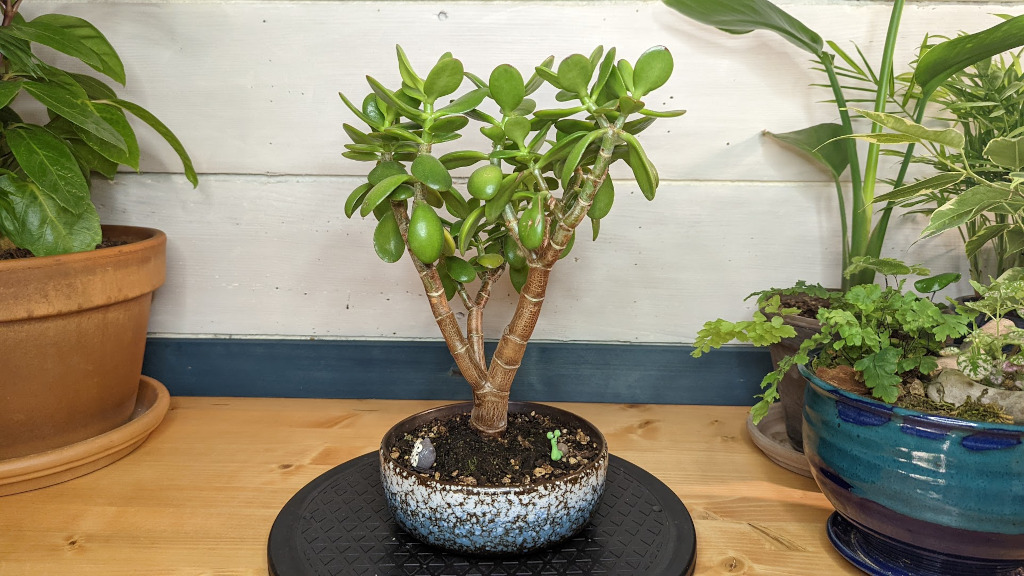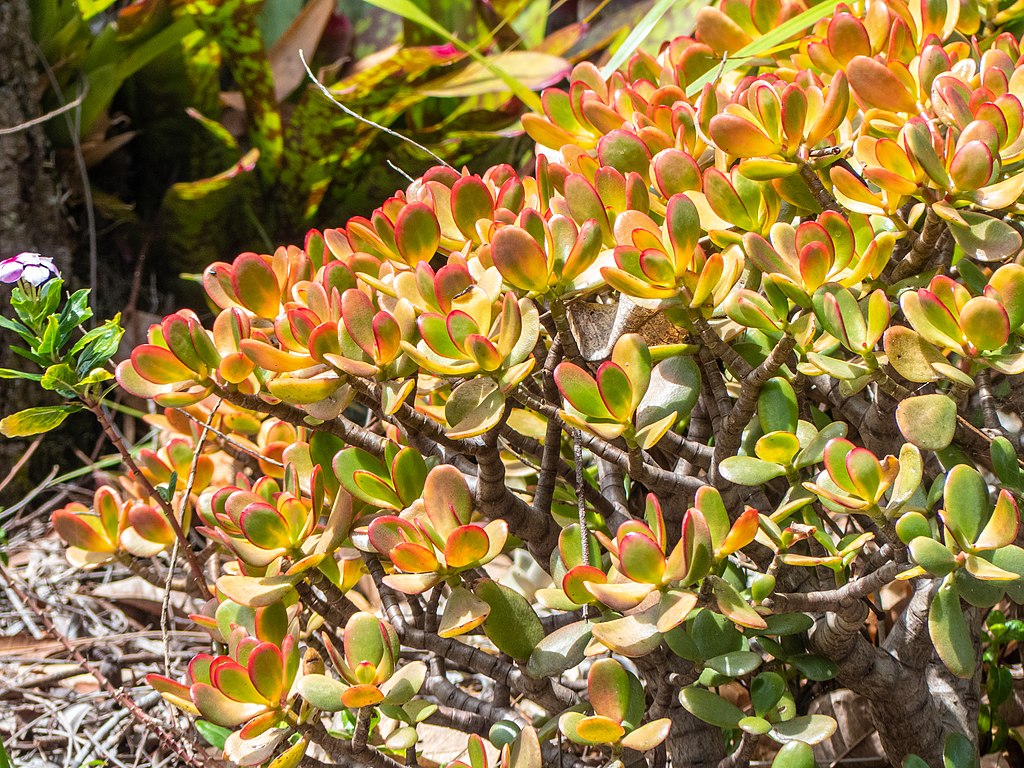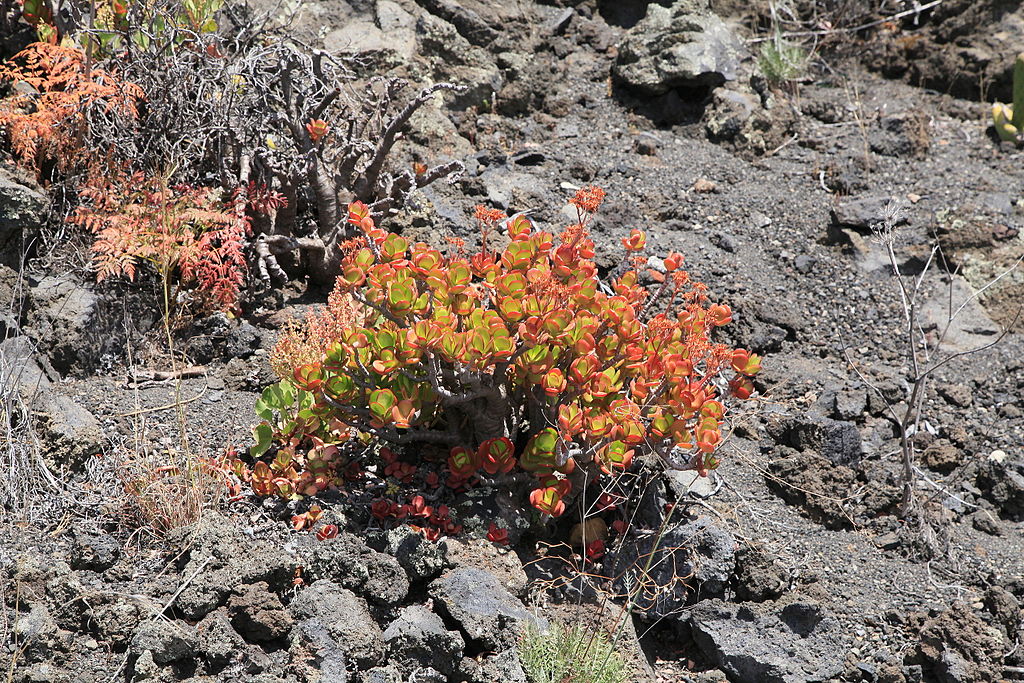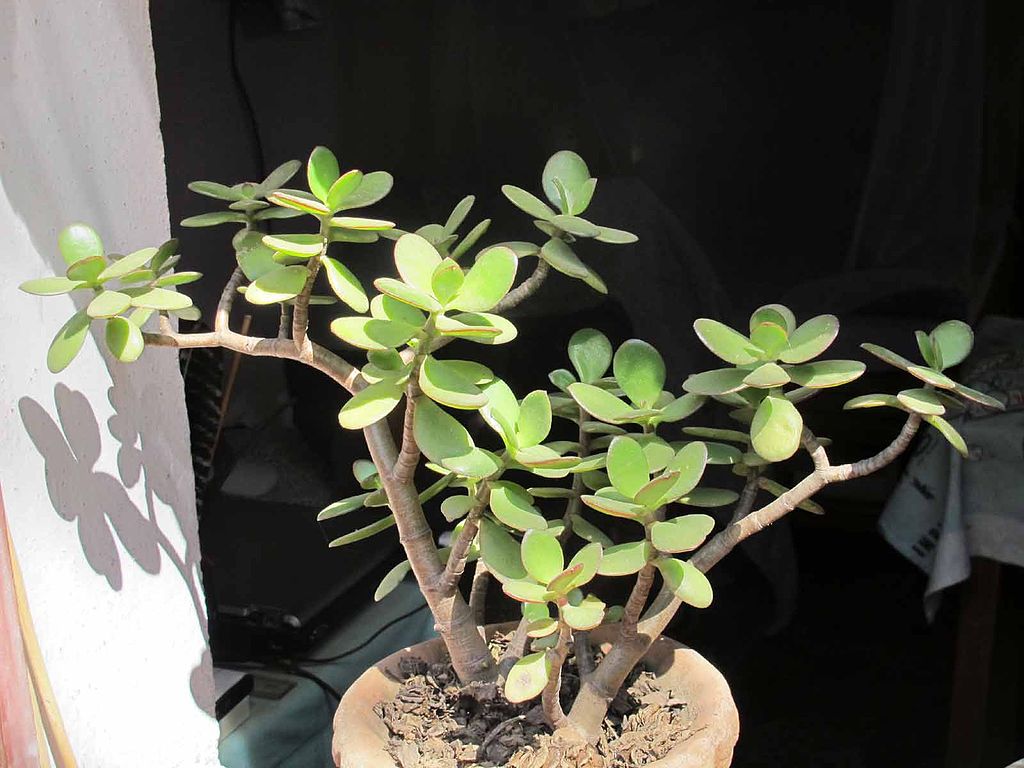Common: Jade
Growers love the jade plant (Crassula Ovata, Crassula Argentea) as bonsai material for good reasons:
- The trunk thickens and takes on an aged look very quickly
- Thrives in semiarid conditions (like our homes)
- Responds well to pruning and branches very easily
- It can be wired and shaped into a variety of styles
- In bright sun, the succulent leaves take on red edges
- Even very thick cuttings root easily
Jade is a robust growing evergreen succulent that does well with dry periods, making it an excellent tree for beginners. The versatility and stunning appearance make jade bonsai highly prized by expert growers.
This jade bonsai is only 4 years old, but already has an aged look on the trunk.

The jade plant has been widely adopted across the world as a house plant and is known as the lucky plant or the money plant and the scientific name is Crassula ovata. Crassula argentea, Crassula articulata, Crassula nitida and Crassula obliqua are specific cultivars or synonyms of Crassula ovata.
Jade in Nature
If you want to create the right environment for a bonsai, it is a good idea to understand the natural environments where it naturally thrives. A basic understanding can guide you in making decisions about the tree's care even when you can't find experienced guidance for a specific question or concern.
The jade is an evergreen succulent that grows with a naturally bushy form and can reach 2.5 meters tall. It is native to the subtropical zones of South Africa's eastern coast. The climate is temperate, with only moderate variations with winter lows of 11C (52F) and summer highs of 28C (82F). It is a semiarid region and annually receives between 8 and 24 inches (200 and 600 mm).

The topography of the eastern cape and KwaZulu-Natal province of South Africa is a series of mountains and valleys covered in dry grasslands. The soil in the area is gray sand or sandy loam and not very fertile. The semiarid conditions mean that it is dry for much of the year. The conditions are perfect for jade since it can store water in its leaves, trunks and roots and does well with reduced organic content.
Lighting
Jade bonsai do best in full sunlight to partial shade but survive in low light situations. For best results, position them to get as much sun as possible near a south or west-facing window.
When it is warm outside, jade love to be in the sun. Providing some shade during the hottest part of the day is a good idea during the hottest months.
Temperature & Humidity
Jade trees are native to a very temperate region and can't tolerate extreme temperatures, so keep the temperatures between 11C (52F) and 28C (82F). Their native regions are semiarid and have similar humidity levels to the inside of a human home - though they do fine in higher humidities as well.
Subtropical plants can actively grow year-round. However, it is best to give them a dormancy period if possible. To induce dormancy, move them into a cool area, between 55F (12.7C) and 60F(15.5) for 6 to 8 weeks in the wintertime. Giving them a cool-down period will allow your bonsai to recharge and get ready for strong growth in the spring.
Soil
The native regions of the jade plant have soils that are sandy loam and not very fertile. A safe bet is to use commercial bonsai soil since it is free-flowing and excels at developing roots in small spaces.
With that said, you can easily mix your own pretty easily. The essential aspects of good soil are:
- Loose - Compacted soil won't let the roots breath
- Free Flowing - Waterlogged soil will rot the roots
Jade do well in soil with ample inorganic materials like pumice, lava rock, vermiculite, and perlite because these materials are lightweight, free-draining, and provide excellent aeration. Jade bonsais, especially young ones in training and pre-bonsai states, also benefit from organic matter mixed in the soil. We recommend a mix of 70% inorganic material (pumice, lava, vermiculite, river sand, etc.) and 30% organic materials (pine/fir bark, coco coir, peat moss, composted forest products, etc.)

You can start with a high-quality succulent mix, which will contain plenty of organic materials already, and add some more sand, perlite, pumice, lava, or other inorganic media. Many bonsai growers skip the organic materials altogether.
Jade bonsais are native to regions with slightly alkaline soil pH, between 7 and 7.5 but are tolerant of more acidic soils. Adding peat moss or pine bark will lower pH (more acidic), and adding lime will raise the pH (more alkaline). Use caution when adjusting pH, and be sure to test your soil since you can easily create an environment too alkaline or too acidic for the plant to survive.
Water
Knowing when to water your Jade bonsai is simple: wait until it is completely dry. For summertime, you may need to water every day, depending on the size of the container. While the weather is cool or the plant is dormant, watering will be less frequent.
Make sure to water entirely every time you water until it runs from the bottom of the pot. Water running through the drainage holes will help ensure that all the soil gets wet so the roots will expand to the entire potting area, and the runoff will help remove excess salts left by chemical fertilizers.
Fertilizer
Jade bonsai grow in infertile soil but do best when nutrients are available. Apply a balanced, water-soluble fertilizer once a week during peak growing season and once a month during the cooler seasons. Always follow the manufacturer's instructions; overfertilizing can burn the tips of the leaves, and under-fertilizing can cause sluggish growth and can eventually kill your bonsai.

Repotting
Jade is a vigorous root grower who will quickly fill up their pot. You should check your pot at least once a year and repot if they are root-bound. They respond well to root pruning, and you can easily create a radial root base.
Pruning & Wiring
When pruned, jade bonsai responds with ample back budding and will produce new shoots after a hard cutback.
Always sanitize your tools before and after pruning any bonsai to reduce the risk of infection or cross-contamination. While these trees respond very well to wiring, growers often shape them without the need for wiring using clip-and-grow techniques.
Propagating
Jade can be propagated from cuttings very easily, and even large branches quickly root. After removing a cutting from the main tree, set it aside for several days to make the cut end callous over; this will keep it from rotting. Place the cutting at least an inch deep in free-flowing soil. Moisten the soil and then let it dry out entirely before moistening again. Cutting can start root in as little as a few days.